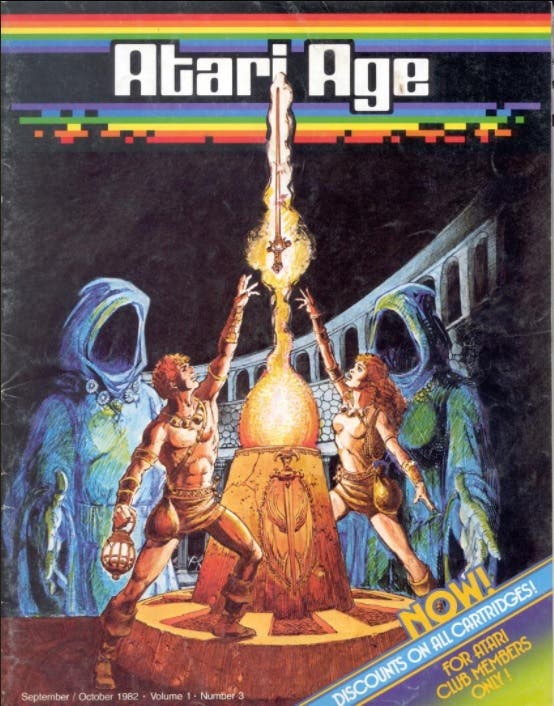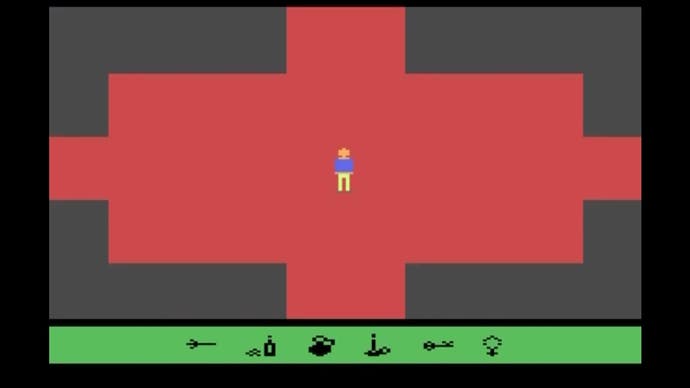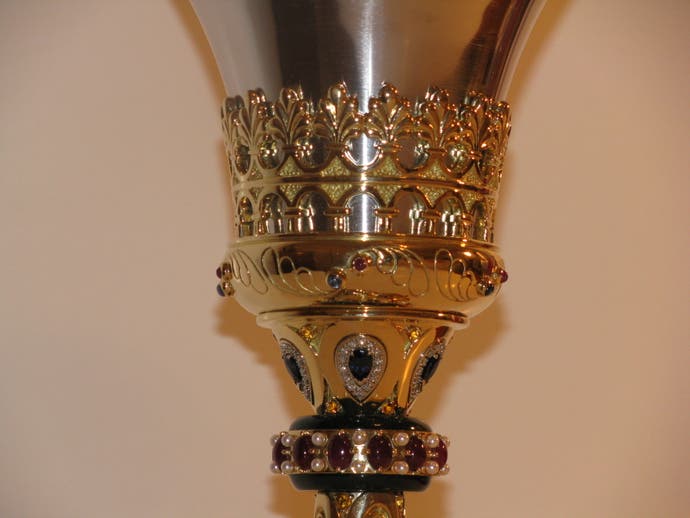The 35-year hunt for Swordquest's lost treasures
Adventure time.
It was the prototypical esports event, in a way. A mixed-media gaming competition Atari launched at the height of its early 80s success, Swordquest pitted players far and wide against a series of four Atari 2600 adventure titles, and then against each other in a grand final for a prize pool of $150,000 in jewel-encrusted treasures. Each game contained clues that revealed hidden messages in an accompanying comic book, and sending the correct message to Atari earned you a chance to compete for a real, honest-to-goodness piece of treasure at its headquarters. All that, without a gaming chair or energy drink in sight.
But the audacious and elaborate Swordquest was never completed. Not long after the first game, Earthworld, released in October 1982, its fate was sealed by the videogame crash of 1983. When the bottom fell out of the market Atari was left facing catastrophe, and suddenly the idea of continuing a competition in which prizes worth five figures were to be given away no longer seemed viable. The competition simply ended midway through. Several of its prizes were never awarded, and the fourth title of the planned quartet, Airworld, wasn't even released.

In the intervening decades, though, a new quest has emerged: to find out what happened to the treasures Atari gave out, the ones it didn't, and the contest winners who never got the chance to compete for the eponymous sword worth $50,000.
Legend has it that the idea for Swordquest began with a lone grey pixel. In 1979 Atari released Adventure for the 2600, a maze-like fantasy game featuring a secret grey dot, one pixel big, which revealed a developer's name when acquired. That grey dot and its hidden power was a big draw, it transpired - and Adventure's legendary secret is often cited as the beginning of the modern day video game easter egg.
The popularity of Adventure's grey dot got Atari's marketing guys thinking. Perhaps players would engage with a game that contained secrets and clues both on-screen and in the real world? From there it snowballed; what began as a sequel to Adventure became a crossover competition with grand prizes, making use of two other assets Atari's parent company Warner owned: DC Comics and Franklin Mint. The former produced a series of comics based in a new Swordquest universe, in which orphaned twins Torr and Tarra journey to discover the treasures upon which the real, physical prizes were based. On certain panels of each issue, bundled with copies of their associated game, hidden words were drawn for players to hunt for using clues they found in-game.
Franklin Mint had the materials to create the treasures, and they were extravagant to an absurd degree. The prize for winning the Earthworld contest was the Talisman of Penultimate Truth, made from solid 18-karat gold and inlaid with diamonds and birthstones of all twelve zodiac signs. On the front was a white gold sword. Fireworld's prize was the Chalice of Light, made of gold and platinum and adorned with citrines, diamonds, green jade, pearls, rubies, and sapphires. Then there were the creations which were never won: the solid gold Crown of Life, encrusted with aquamarines, diamonds, green tourmalines, rubies, and sapphires; the Philosopher's Stone, a white jade rock encased in an 18 karat gold box encrusted with diamonds, emeralds, citrines, and rubies. And the grand prize, valued at $50,000 in 1982: The Sword of Ultimate Sworcery, built with a gold handle inlaid with jewels and a silver blade.
The games themselves were simple: navigate between a series of rooms, find hidden treasures within them, and lay those treasures in the right place. Doing so would trigger the appearance of a clue: it would be a set of two numbers. Applying those numbers to the corresponding page and panel in the comic book would reveal where a hidden word was located. And if you gathered all ten clues, then noticed that the words 'prime' and 'numbers' were printed in a slightly different colour in the game manual's first page and arranged only the clues found on prime numbered pages on the comic... then well done, you had the correct phrase. If it sounds Byzantine now, in the post-ARG age, imagine what it must have been like to navigate in 1982.
It's little wonder that out of the 5,000 Earthworld competition entries Atari received, only eight had found the correct phrase. That elite group were invited to the company's headquarters in San Francisco to compete against each other in a special contest version of the game, under a 90-minute time limit. And of that eight, 20-year-old Detroit resident Steven Bell prevailed and won the $25,00 Talisman of Light.

Bell and his Talisman are the first enigma of the Swordquest story - shortly after winning the Earthworld contest, the whereabouts of both winner and prize became a mystery. One thing was apparent, though: Bell harboured little romantic sentiment for his valuable prize. Asked by a reporter immediately following the contest what he planned to do with the talisman, he said he'd probably just sell it. He might melt it down and buy a car with the proceeds, he continued. "I've never had one."
The trail goes cold on Bell soon after his appearance at the Fireworld finals in 1984, but the fate of his talisman is now agreed upon. According to Curt Vendel, author of 'Atari Inc. Business is Fun' and former consultant at the company, all that remains of it is the white gold sword: "He did melt down the talisman and kept several parts of it," he tells me, "but it appears to be gone as a whole." Having lost contact with Bell over 15 years ago, he's not even completely sure about the white gold sword's survival.
That would make Michael Rideout, winner of the Fireworld Contest, the sole owner of one of Swordquest's treasures in 2017. His Chalice of Light is still, 35 years on, safe and intact. "I still have it," he tells me. "There's an occasional temptation to sell it, but I don't intend to ever sell it unless I truly need the money."
Rideout was among a larger group who correctly deciphered the phrase in Fireworld than had done so in Earthworld, so in addition to the clues he also had to send Atari a brief letter about what he had enjoyed about the game. The exact details of that letter aren't remembered, but they did the trick: he won himself a trip to San Francisco.

Rideout beat the game in under 50 minutes, using knowledge of the Tree of Life he'd picked up from dabbling in Tarot to figure out the corresponding items and rooms. Having never expected to win, he suddenly found himself holding a platinum chalice and posing for photos.
It was there, at the Fireworld finals, that Rideout met Bell. "I don't know what ever became of Steven," he says. "He had the EarthWorld talisman melted down by a coin dealer. I remember that he did say so himself, because he was warning me that the chalice wasn't going to be worth as much as what Atari said." Keeping only the white gold sword, Bell recieved $15,000 for the rest. However, Vendel disagrees with Bell's assertion about the prizes being overvalued: "The valuations came from the Franklin Mint and for legal coverage they would need to keep the valuation [within five per cent] of actual value."
The next mystery Swordquest would present would be the Waterworld finals. The third game was made available only to Atari Club members, and no-one who qualified for the finals - which Vendel says had to take place, by law - has ever come forward to offer any information on it. It's not even clear whether the Crown of Life ever found an owner, although based on a letter he received from Atari after new CEO Jack Tramiel took over in 1984, Rideout suspects not.
"It was from the new Atari, or their lawyers, stating that they were under no obligation to continue the contests. They offered to give Steven Bell and myself $15,000 each, and to give the ten WaterWorld finalists $2000 each, as consolation or compensation for discontinuing the contests."
It was money to compensate for the finalists becoming unable to compete for the $50,000 Sword of Ultimate Sorcery. According to that letter, there had to be 100% agreement between all parties - the $15,000 cheque Rideout received a few weeks later indicated that such an agreement had been reached. Vendel also agrees that although Atari were obliged to hold the Waterworld contest, they weren't obliged to hand out the Crown of Life, and that a cash prize may have been offered instead. However the final took place, it never became public knowledge.
Swordquest's greatest mystery now lies in the whereabouts of its remaining treasures: the Crown of Life, Philosopher's Stone and Sword of Ultimate Sorcery. There are three theories. The first suggests they were all melted down after the competition was cancelled. The second, Atari CEO Jack Tramiel kept them for himself. And finally, some believe that they still exist somewhere, perhaps gathering dust in a bank vault or displayed in a - very - private collection.

Sadly, the first theory is also the most likely. According to Vendel, they were indeed melted down by Franklin Mint almost immediately after Tramiel took over. "Warner sold the Franklin Mint to American Protective Services in 1985," he says, which meant that when Atari were sold and reborn as Atari Corp, the items would have been placed back in Franklin Mint's possession. "Most likely [the remaining treasures] would've been immediately returned to the smelting division, melted down and the jewels used in other products."
A spokesperson for the Franklin Mint told me that since no-one currently on its books worked there at the time, they have no information on the whereabouts of the items or what became of them.
As for the rather more salacious idea that the new boss took the treasures for his own, there's nothing to support the theory beyond a rumour among Atari staff that Tramiel had the sword on display in his office. It certainly runs contrary to the legal ownerships situation Vendel describes, but for some, it's too poetic an outcome to discount. Tramiel's son, Leonard, could not be reached for comment.
But as long as there's a shadow of a doubt, the search for answers continues - even in the face of a rather prosaic probable scenario, that items born as treasures and which captured the imaginations of gamers as such, would ultimately become business assets.

